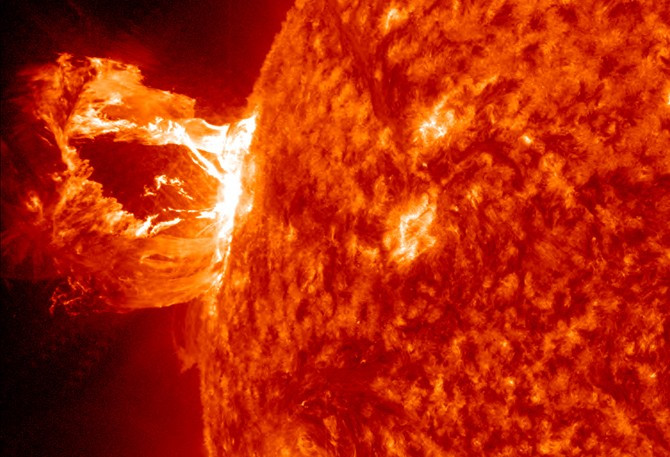NASA Scientists Capture Stunning Images of Solar Flares From Sun [PHOTO + VIDEO]

Nasa's Solar Dynamics Observatory (SDO) has captured the stunning images of solar flares from the Sun on 16 April.
A massive amount of intense super-heated solar plasma was raised by the solar flares in an explosion known as coronal mass ejection (CME). The eruptions blasted off the east limb (left side) of the Sun.
The powerful solar flare occurred at 1:45 p.m. EDT (17:45 GMT) and registered a M1.7 class (medium-sized) on the scale scientists used to measure flare strength, said Nasa.
"A large coronal mass ejection blasts off over the eastern limb of the Sun. Great eruption happening on the Sun now," Nasa scientists posted a message on twitter.
Coronal mass ejections are associated with solar flares and can also occur independently. Both the solar flares and coronal mass ejections occur as a result of the magnetic activity on the Sun.
The solar flares occur due to an intense burst of radiation that comes from the release of magnetic energy associated with sunspots. These solar flares appear as bright areas on the sun and their explosion can last from minutes to hours. Such flares are monitored using x-rays and optical light.
Coronal Mass Ejections are the sudden release of huge bubbles of gas when the magnetic fields that structure the corona are closed above the sun spots. While the solar flares develop much more rapidly, with much more energy, CME from the Sun appear over the course of several hours.
CME can disrupt the flow of the solar wind and can also cause disturbances that strike the Earth which may result in a catastrophe. A large CME can contain a billion tons of matter which can be accelerated to several million miles per hour in a spectacular explosion. Dr. Art Poland, an astrophysicist, told the National Geographic that the particles in the CME can travel some 200 to 1,000 kilometers per second (124-621 miles per second).
These extremely powerful CMEs sometimes can pose a danger to astronauts and satellites in space, as well as the earth by knocking off power grids, navigation and communications systems. But the CME that was captured on Monday was not directed towards earth.
The frequency of flares coincides with the Sun's eleven year cycle. When the solar cycle is at a minimum, active regions are small and hence very few solar flares are detected. As the Sun approaches the maximum part of its cycle, the number of solar flares increase. The sun is currently in an active phase of its 11-year solar weather cycle and is expected to reach its peak activity in 2013. The current solar weather cycle is known as Solar Cycle 24, which began in 2008. The last big flare occurred in 1859 that saw the skies all over planet Earth erupting in red, green, and purple auroras so brilliant in the night that even newspapers could be read as easily as in daylight, according to Nasa.
The eruptions caused disruptions to the telegraph systems and also caused power shortage. There have been reports suggesting that such huge solar flare is due to erupt in 2013 causing blackouts and global chaos.
© Copyright IBTimes 2025. All rights reserved.





















